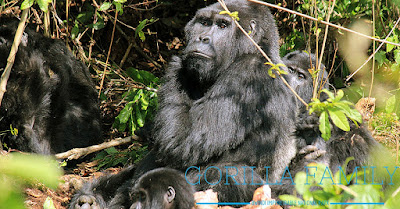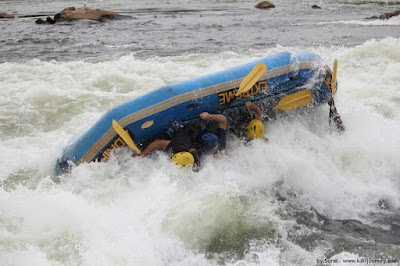There are many cool and fun places in the world to go rafting and the Nile in Uganda to be specific a town called Jinja is one of them.
Companies like Equatorial Wild Safaris, Adrift and Nile Adventures can help you plan your rafting adventure at very good prices. They do offer a variety of rafting packages to for you to choose from.
The Experience
Your day would definitely begin with an early morning pickup from your overnight stay to where you will be doing the rafting from, then breakfast perhaps coffee with some snacks and you are as good as ready for the adventure.
This is probably your first time to do the rafting in Uganda so you will need to listen to you guide for the safety measures like how to set in the boat, where the rapids will be or how to get back into the boat when you fell out while rafting. I would go on and tell you how cool and adventurous rafting is but it all always sounds better when you hear it from a fellow traveler who has been there. On the June 5 of 2013 Vlaicu Sorin went rafting here he share his experiences
Vlaicu Sorin shares his experience
……………….. And we start rolling. First half hour was fun, easy and relaxing. Just rolling and enjoying the view. First rapid was just in front of us and it was a category one! The highest one is category 6 and only the experienced people can do it because at category one you have to stay under water 1 minute. For category 6 you can stay up to 20 seconds. Strange, I wasn’t scared. And it passed quite well, fast, with adrenaline and no incidents. It was super fun!
Second rapid was a Class 3 and I thought it so easy to pass through it. In order not to slip you have to paddle very hard and in the right direction, back or forward as your guide instructs.
And then the third one came! A class 3 rapid too called the Easy Ride. Not sure why it’s called easy because it wasn’t at all. Not sure why we flipped into the water. I am pretty sure the guide wanted us to flip. I wasn’t prepared at all. Put the paddle into the boat, as required, holding with one hand the rope close to the edge and was waiting for the rapid to pass gently. But it didn’t! And next second I found myself under the water. I do have a problem; i don’t know how to breathe under the water. Had to have one hand holding my nose. The first thing I remember was that I was swallowing some water through the nose and mouth. Tried to reach the surface to breath, but a wave hit me and I was again for few seconds underneath then, finally managed to be above and be able to breathe a bit normally. I was looking desperately for the rescue kayak and my boat. After a few seconds i spotted one and was trying to reach it with my paddle, which strangely remained next to me until i managed to get to safety. The guide laughed at me while I was struggling to get out of the water after the flip. I was really scarred!
A well-deserved swimming break into the Nile arrived. For half an hour i just stayed and relaxed into the warm waters of the Great Nile. Last rapid before the lunch was a class 3 too. Still scared not to flip again, I was holding very tight the boar and paddling quite hard in order to not keep the boat flipped. Fortunately, we didn’t flip!
Lunch was taken on the Wakisi Island. Fresh avocados, juicy pineapples and succulent tomatoes combined well with cured ham, cheese, potato salad and fresh bread was served to us. It was a perfect lunch to fill our batteries for the second part of our rafting adventure.
The break was gone and the second part was about to come. And what a start to it! The next rapids were called “The Bad Place” grade 5 and 6. It was huge and very, very scary. We had three options. Number four was out of the question because it was a class 6 rapid! Ours was a 5 class and we had to choose between a 100% flip, 50-50 flip and the chicken run. No one wanted the chicken run; some wanted the 100% flipped, but I was too scared to go again into the water. My call was in the 50-50 rapid. And I was lucky. My prayers had been listened to and no flips happened this time! Yuppie!
Our guide was a bit unhappy because we hadn’t flipped. But he was soon to be. Six out of eight rapid was about to come, a class 4 rapid. I knew we were about to flip into the water the moment I saw the big wave hitting us but this time I was ready. Tried to keep my breath, kept my calm and managed to be out of the water very fast. To be honest, it was a nice flip. But 2 flips in one day were to be enough.
Last rapids of the day, a 3 and 3+ class rapid were pretty easy. It was a perfect day for rafting. Not too much sun, not too much heat and the water was warm.
The day ended after almost 8 hours of paddling. I could hardly walk or feel my hands. After a cool and healthy barbecue, the picture was shown to us. At first I didn’t want to buy it. 50$ it was a big amount to be paid for 10 photos. But after seeing it, I said what the heck! Who knows when I will be doing it again?
Overall, it was one of the best experiences I had in Africa. I had little time to spend in this magnificent continent and the rafting experience will be one not to be ever forgotten!
Original Author: Vlaicu Sorin
Source Website: http://www.kikijourney.com/the-rafting-experience/











